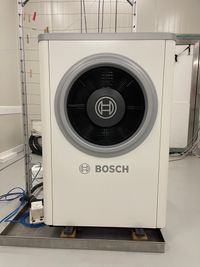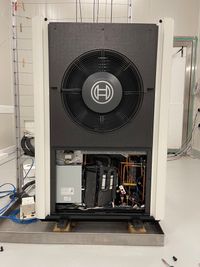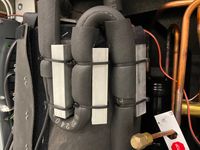More Efficient Refrigerant Cycling for Reduced Energy Consumption in already Installed and Future Air Conditioning and Refrigeration Systems
Our Mission
Our mission is to sustainably enhance existing refrigerant compression processes in air conditioning (HVAC) and refrigeration, with a focus on the reduction of energy consumption and carbon emissions.
Our commitment is to quickly and conveniently improve current and coming HVAC and refrigeration systems with a holistic approach that integrates the best of traditional as well as innovative and disruptive practices that are safe and based on natural science, driving innovation that optimizes energy efficiency, reduces greenhouse gas emissions, and achieves cost reductions (resources/infrastructure) by reducing energy consumption.
With our proven and flexible instrument for innovative refrigerant cycling applications, we aim to create a high-technology and effective energy solution.
Our Goal
Our goal is to reduce electricity consumption of existing HVAC and refrigerant systems by 50%, focusing on a product solution that can be quickly and conveniently installed to increase the efficiency in refrigerant cycling.
Cooling and refrigeration technologies are essential to every aspect of life, from homes and workplaces, food and medicine supply chains, to data centers that power knowledge industries. As a by-product of economic development, the demand for these technologies – from residential, commercial, and industrial HVAC and refrigeration – is rapidly increasing.
Our aim is to lead the way with a product solution in sustainable refrigerant cycling, reducing emissions and enhancing energy productivity with a fast and convenient market roll-out. With our proven solution, we are dedicated to reducing energy consumption with HVAC units and refrigerators by 50%.
Opportunities in Refrigerant Cycling
The world is witnessing a rapid increase in the adoption of HVAC systems and a corresponding increase in electricity consumption with related emissions. This phenomenon is the result of several converging factors, including population growth, rising incomes, falling equipment prices, and urbanization. There are major consequences and the requirement for energy-efficient HVAC solutions is more critical than ever. By 2050, it is anticipated that around 65% of households worldwide will have air conditioning - with China, India, and Indonesia accounting for 50% of all HVAC units.
The widespread adoption of air conditioning has transformed cooling into the fastest-growing consumer of energy in buildings. Today, HVAC systems account for approximately 20% of the total electricity consumed in buildings, equivalent to 10% of global electricity consumption. Projections indicate that the energy demand for space cooling will more than triple by 2050.
One of the major issues with HVAC technology is its inefficiency. The basic principles of air conditioning, based on the vapor compression cycle, have not changed significantly since its invention in 1902, similar to the operation of refrigerators (still, HVAC has greater potential for energy efficiency improvements than refrigeration). Therefore, enhancing HVAC efficiency without requiring a complete overhaul and refurbishment of modern cities becomes an essential goal.
The ever-increasing demand for space cooling puts tremendous pressure on electricity systems, resulting in higher air pollution, emissions, and water usage. Efficient HVAC units can significantly reduce the need for power generation and network capacity to meet peaking electricity demand, cutting both carbon emissions and operating cost.
It is estimated, that around 25% of global warming will be attributed to air conditioning by 2050. Advancements in equipment efficiency can significantly contribute to reducing emissions and to ensuring a sustainable and energy-efficient future.
More Efficient Refrigerant Cycling
In air conditioning and cooling, the reduction of energy consumption is a predominant goal. Our innovation in cooling has been demonstrated with the QFT ENERGY REFRIGERANT Solution, which offers an innovative way to improve refrigerant cycling, enhancing the energy efficiency in HVAC and refrigeration systems, all without the need for intrusive software or hardware changes.
Flexible materials and specifications: Future materials, sizes and formfactors can be chosen freely. Currently, our product solution is crafted from an aluminum carrier material (AlMgSi0.5), the compact square bar product solution measures 20 x 20 x 100 mm and weighs 100 grams
Non-intrusive: Our solution does not interfere with the refrigerant cycling process itself. It is about flexibly supplementing and improving existing hardware and processes without the need for costly or complex modifications.
Versatile compatibility and installation: Within a few minutes, our QFT ENERGY REFRIGERANT Solution can be easily and conveniently attached to the outside or the inside of any existing refrigerant cycling system, irrespective of the manufacturer and hardware size. It should strategically be placed near the refrigerant compression, ensuring maximum impact.
Results in Adjacent Application with Heat Pumps
Efficiency improvement results of the QFT ENERGY REFRIGERANT Solution have been obtained through comprehensive testing in real-world conditions (in this case, used for certifying efficiency levels of heat pumps launched into the market), conducted as part of the QFT Heat Pump Test. The test was performed and the data was verified by the Heat Pump Test Center (WPZ), the European heat pump efficiency certification body of St. Gallen University, Buchs in Switzerland.
Heat Pump specification: BOSCH Compress 7000i AW 7, efficiency class A++, capacity 7 kW
Equipped with the QFT ENERGY REFRIGERANT Solution on the compressor (see detailed view)
Overview of the QFT Heat Pump Test Set-up at the Heat Pump Test Center (WPZ)
Energy efficiency increase: In this already very energy-efficient, up-to-date A++ heat pump system, our solution led to a reduction in electrical energy consumption, with savings of up to 28%.
Quick and Convenient Cooling Efficiency Improvement
By aiming to improve refrigerant compression efficiency and to decrease energy consumption by 50%, our QFT ENERGY REFRIGERANT Solution represents a quick and conveniently installed approach to optimize refrigerant cycling for HVAC and refrigeration systems, offering a non-intrusive solution that significantly reduces energy consumption and subsequently reduces greenhouse gas emissions.




